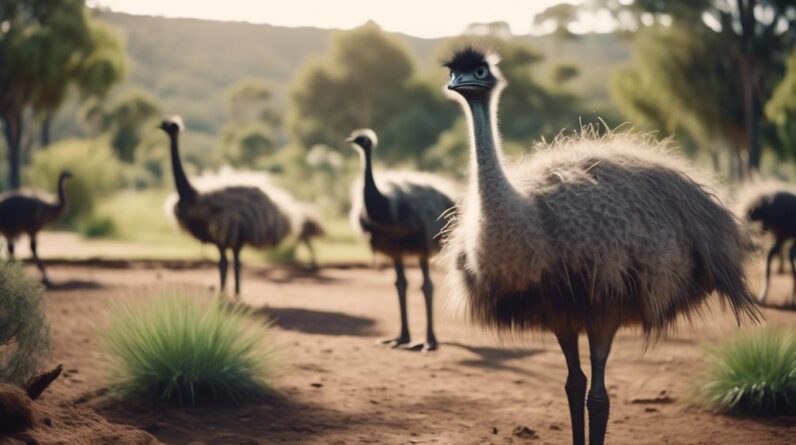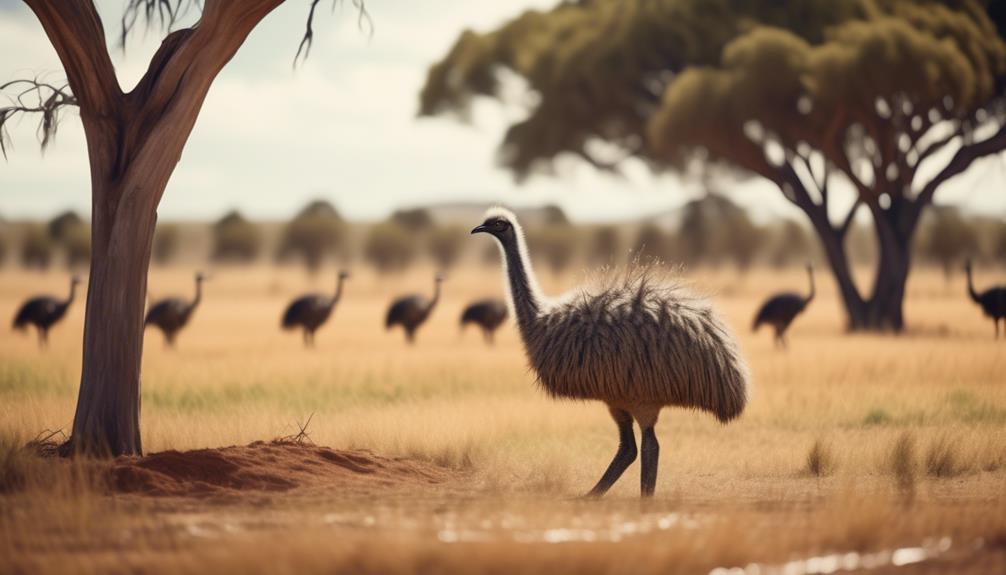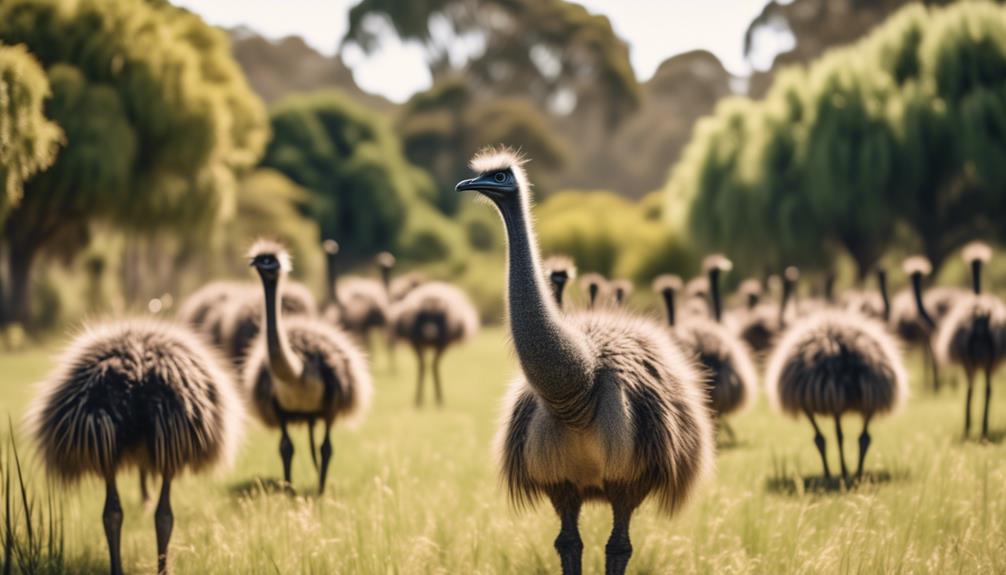
Imagine a world where conservation and sustainability are seamlessly integrated into agricultural practices, like the intricate threads of a tapestry. Emu farming, with its remarkable potential to promote both the preservation of natural habitats and the production of sustainable food, stands as a shining example of this harmonious relationship.
But how exactly does this unique farming model achieve such impressive feats? In this discussion, we will explore the low ecological footprint of emu farming, its role in habitat preservation, and the ways in which it fosters species diversity.
Prepare to be amazed by the sustainable land management practices employed by emu farmers, and join us as we uncover the potential of emu farming as a conservation solution and a path to a greener future.
Emus: A Sustainable Farming Alternative

Emus offer a sustainable farming alternative that can effectively contribute to conservation efforts and address the growing need for environmentally-friendly agricultural practices. Emu farming is a form of sustainable agriculture that minimizes the environmental impact while providing economic benefits.
One of the key advantages of emu farming is its low resource requirements. Emus are well adapted to a range of climates and can thrive on a variety of vegetation, reducing the need for intensive land and water use. Additionally, emus have a low carbon footprint compared to traditional livestock, as they produce less methane gas and require less feed.
Emus are also known for their efficient conversion of feed into meat and oil, making them a cost-effective option for sustainable farming practices. Emu meat is lean, high in protein, and low in cholesterol, making it a healthy alternative to traditional meats. Emu oil, extracted from their fat, is rich in omega-3 fatty acids and has numerous health benefits.
Low Ecological Footprint of Emu Farming
Emu farming boasts a remarkably low ecological footprint, making it a sustainable and environmentally-friendly option for agricultural practices. When considering the environmental impact of emu farming, it’s important to note that emus have a unique digestive system that allows them to efficiently convert food into energy. Unlike other livestock, emus produce significantly less methane, a potent greenhouse gas, during digestion. This reduces their contribution to climate change and lowers their carbon footprint.
Furthermore, emus are adaptable and can thrive in various environments, including arid and semi-arid regions. They can consume a wide range of vegetation, including grasses, shrubs, and even cacti, which reduces the need for intensive agricultural practices such as land clearing and irrigation. Emu farming requires less land, water, and feed compared to traditional livestock farming, minimizing resource depletion and environmental degradation.
In addition, emus have a low input-output ratio, meaning they require less energy and resources to produce a given amount of meat and oil. This efficiency further contributes to the low ecological footprint of emu farming.
Emus and Habitat Preservation

Preserving habitats is crucial for the long-term survival of various species, and emu farming plays a significant role in supporting habitat preservation efforts. Emus, as native inhabitants of Australia, have adapted to a range of ecosystems, making them ideal candidates for ecosystem restoration projects. By reintroducing emus to degraded habitats, we can facilitate the restoration of diverse plant and animal communities.
Emus have a unique foraging behavior that can positively impact habitat restoration. As they move through the landscape, emus disperse seeds through their droppings, promoting the growth of native vegetation and enhancing biodiversity. This seed dispersal mechanism is particularly important in areas where the natural seed dispersers, such as large herbivores, have been lost or depleted.
Furthermore, emus also contribute to wildlife conservation efforts. By creating suitable habitats for emus, we indirectly create suitable habitats for other wildlife species that depend on similar ecological conditions. Emus can serve as ‘umbrella species,’ meaning that their conservation benefits a wide range of other species that share the same habitat requirements.
Emus Promoting Species Diversity
Promoting species diversity, emus play a crucial role in enhancing the ecological health of their habitats. Emus are known to be effective seed dispersers, helping to maintain the balance of plant species in their ecosystems. As they forage for food, emus consume a variety of fruits and seeds, which pass through their digestive systems relatively intact. This means that when emus defecate, they spread these seeds across their habitats, aiding in their germination and dispersal. By doing so, emus contribute to the establishment and maintenance of diverse plant communities.
Studies have shown that emus can disperse seeds over long distances, allowing for the colonization of new areas by different plant species. This process is crucial for biodiversity conservation as it helps to prevent the dominance of certain plant species and promotes the establishment of a diverse array of vegetation.
In the context of emu farming, these natural behaviors can be harnessed to aid in ecosystem restoration. Selective grazing and controlled release of emus in degraded areas can help restore vegetation, increase plant diversity, and promote the recovery of ecosystems. Emu farming practices that align with ecological principles can therefore serve as a powerful tool for biodiversity conservation and ecosystem restoration.
Sustainable Land Management Practices in Emu Farming

To ensure the long-term sustainability of emu farming, implementing effective land management practices is essential. By adopting sustainable grazing techniques and practicing soil fertility management, emu farmers can optimize the productivity of their land while minimizing environmental impact.
Here are four key practices that can be implemented:
- Rotational grazing: This practice involves dividing the land into smaller paddocks and regularly moving emus to different areas. By allowing the vegetation in each paddock to rest and regenerate, rotational grazing helps maintain a healthy balance between emu grazing and plant growth, preventing overgrazing and soil erosion.
- Managed intensive grazing: Emu farmers can use this approach to concentrate emus in specific areas for a short period. This allows for more efficient utilization of the land, as emus graze intensively before being moved to another area. It also stimulates plant growth through trampling and nutrient cycling.
- Composting and organic matter addition: By composting emu manure and incorporating it back into the soil, farmers can improve soil fertility and structure. This practice enhances nutrient cycling and increases water-holding capacity, promoting healthy plant growth.
- Cover cropping and crop rotation: Planting cover crops, such as legumes or grasses, during fallow periods helps suppress weeds, control erosion, and improve soil health. Additionally, rotating crops can minimize nutrient depletion and pest pressure, contributing to sustainable land management.
Economic Benefits of Emu Farming
Emu farming offers a range of economic benefits that contribute to sustainable agriculture and rural development. The economic impact of emu farming can be significant, with various revenue streams generated from the sale of emu products and by-products. Emu meat, known for its lean and healthy properties, is in high market demand due to its low fat content and high protein content. Emu oil, derived from the bird’s fat, is used in various industries such as cosmetics, pharmaceuticals, and dietary supplements. The feathers and eggs of emus are also valuable commodities. The following table highlights some of the economic benefits of emu farming:
| Economic Benefits | Examples |
|---|---|
| Income Generation | Sale of emu meat, oil, feathers, and eggs |
| Job Creation | Farm workers, processors, and distributors |
| Diversification | Offering additional revenue streams for farmers |
| Rural Development | Stimulating local economies and supporting small-scale farmers |
The economic benefits of emu farming not only contribute to individual farmers’ income and livelihoods but also have wider implications for rural development. By diversifying their agricultural activities, farmers can enhance their resilience and sustainability. Emu farming provides an opportunity for farmers to tap into a profitable market demand while contributing to sustainable land management practices.
Emu Farming and Resilient Agriculture

By incorporating emu farming into your agricultural practices, you can strengthen the resilience and sustainability of your operations while contributing to the principles of resilient agriculture. Emu farming offers several benefits that can help you adapt to the challenges posed by climate change:
- Drought tolerance: Emus are well adapted to arid and semi-arid environments, making them resilient to water scarcity. By raising emus, you can diversify your livestock portfolio and reduce your dependence on water-intensive animals.
- Low-input requirements: Emus are hardy animals that require minimal inputs such as feed and medication. This can help you reduce your production costs and increase your resilience to market fluctuations.
- Soil health improvement: Emus have a low impact on grazing land, as they graze lightly and distribute their droppings evenly. This can promote soil health and fertility, enhancing the long-term sustainability of your agricultural operations.
- Diversification of income streams: Apart from their meat and oil, emus also provide feathers, eggs, and leather, which can be sold for additional income. Diversifying your income streams can help you withstand economic shocks and ensure the resilience of your farm.
Emu Farming as a Conservation Solution
Emu farming has emerged as an effective conservation solution, providing opportunities for the restoration of ecosystems and the protection of endangered species. Conservation benefits are derived from the environmental impact that emu farming has on the land. Unlike traditional livestock farming, emus have a much lower environmental footprint. They require less water, food, and space, making them a more sustainable option for agricultural practices. Furthermore, emus have a unique ability to graze on a wide range of vegetation, including invasive plant species that threaten native ecosystems. By consuming these plants, emus help restore habitats and improve biodiversity.
Emu farming also plays a crucial role in protecting endangered species. As emus graze on invasive plants, they create suitable conditions for native vegetation to thrive. This, in turn, attracts native wildlife, including endangered species that rely on specific plant communities for their survival. By promoting the growth of native vegetation, emu farming indirectly contributes to the conservation of these species.
Additionally, emu farming can serve as a model for sustainable land management practices. By integrating emus into agricultural systems, farmers can reduce the use of chemical herbicides and pesticides, which can have detrimental effects on the environment. Emu farming offers a more natural and eco-friendly alternative for maintaining healthy ecosystems.
Emus and Sustainable Food Production

As we explore the topic of sustainable food production, it’s important to consider the potential role of emus in ensuring a more environmentally friendly and resource-efficient agricultural system. Emus offer several advantages when it comes to sustainable farming practices and the production of nutritious food. Here are four key reasons why emus can contribute to sustainable food production:
- Efficient land utilization: Emus require less land compared to traditional livestock such as cows or pigs. They can be raised in smaller spaces, allowing for more efficient land use and reducing the overall environmental footprint of the farming operation.
- Low water consumption: Emus have adapted to arid environments and can survive on minimal water intake. This makes them well-suited for regions with water scarcity or drought conditions, where traditional livestock may require significant water resources.
- Nutrient-rich meat: Emu meat is a lean protein source that’s low in fat and cholesterol. It’s also rich in omega-3 fatty acids, iron, and zinc. Incorporating emu meat into the diet can provide nutritional benefits while reducing the reliance on more resource-intensive meats.
- Versatile byproducts: Emus produce valuable byproducts such as feathers, oil, and leather. These can be utilized in various industries, reducing waste and providing additional economic opportunities for farmers.
Emu Farming: A Path to a Greener Future
The adoption of emu farming practices has the potential to pave the way towards a more environmentally sustainable and resource-efficient future. Emu farming offers greener farming practices that can greatly reduce the environmental impact of traditional agricultural practices.
One key aspect of emu farming that contributes to a greener future is the low carbon footprint associated with raising emus. Emus are highly efficient converters of feed into meat, requiring significantly less feed per pound of meat produced compared to traditional livestock. This means that less land is required for feed production, reducing deforestation and habitat loss. Additionally, emus produce less methane, a potent greenhouse gas, compared to other livestock such as cattle.
Furthermore, emu farming can also contribute to a greener future by reducing water consumption. Emus have a lower water requirement compared to traditional livestock, making them more water-efficient. This is particularly important in regions where water scarcity is a concern.
In addition to their low carbon footprint and water efficiency, emus can also contribute to a greener future through their waste management. Emu manure can be used as a natural fertilizer, reducing the need for synthetic fertilizers that can harm the environment.
Frequently Asked Questions
How Long Do Emus Typically Live in Captivity?
Emus typically live for about 10 to 20 years in captivity. They reach breeding age at around 2 to 3 years old. These factors play a crucial role in emu farming and the overall sustainability of the industry.
What Are the Primary Food Sources for Emus on an Emu Farm?
On an emu farm, emus primarily feed on a variety of sources to meet their nutritional requirements. These sources include grasses, fruits, vegetables, and specially formulated emu feed. Ensuring a balanced diet is crucial for their health and well-being.
How Does Emu Farming Impact Local Wildlife Populations?
Emu farming has the potential to negatively impact local wildlife populations. It can disrupt the ecological balance and decrease biodiversity by altering habitats and competing for resources. However, proper management practices can minimize these effects and promote conservation and sustainability.
Are There Any Specific Land Management Practices That Emu Farmers Must Adhere To?
Are you curious about the guidelines emu farmers must follow in their land management practices? Well, let me tell you, these regulatory requirements are crucial for ensuring environmental sustainability and the long-term success of emu farming.
What Are the Potential Challenges or Risks Associated With Starting an Emu Farming Operation?
Starting an emu farming operation can pose various challenges and risks. These include financial investment, regulatory compliance, disease management, marketing, and finding a reliable market. However, with proper planning and management, these challenges can be overcome.
Conclusion
In conclusion, emu farming offers a sustainable and environmentally friendly alternative to traditional farming methods. With its low ecological footprint, emu farming promotes habitat preservation, species diversity, and sustainable land management practices.
By embracing emu farming, we can pave the way for a greener future, where conservation and sustainable food production go hand in hand. Let the emus lead the way towards a resilient and thriving ecosystem.





